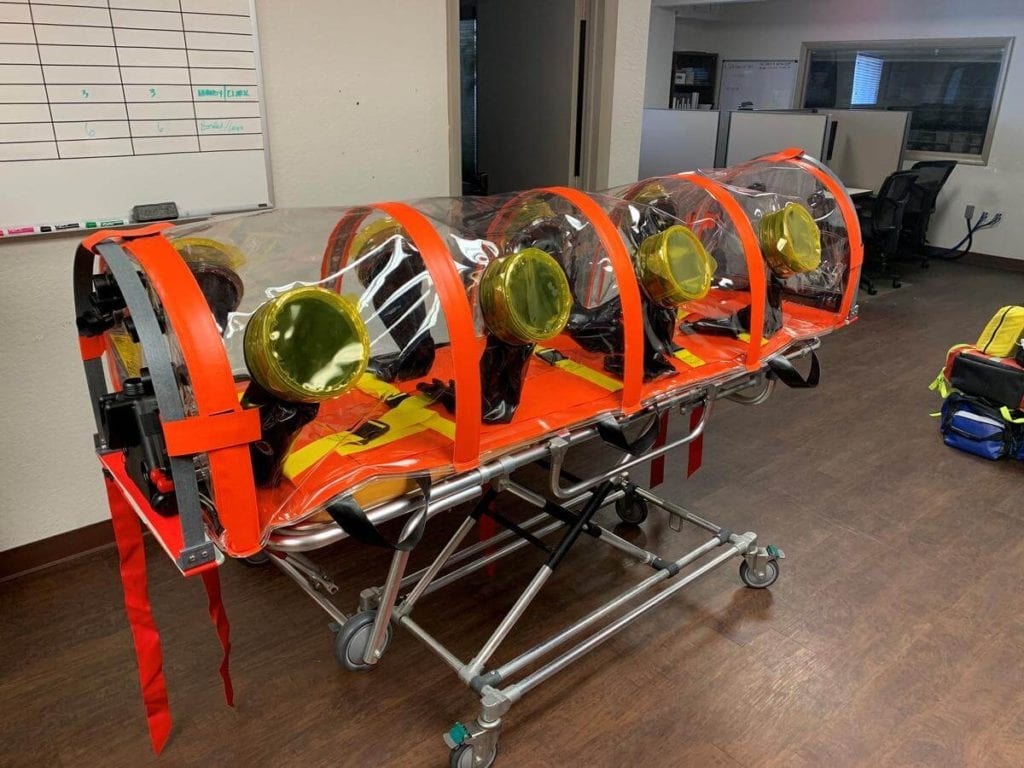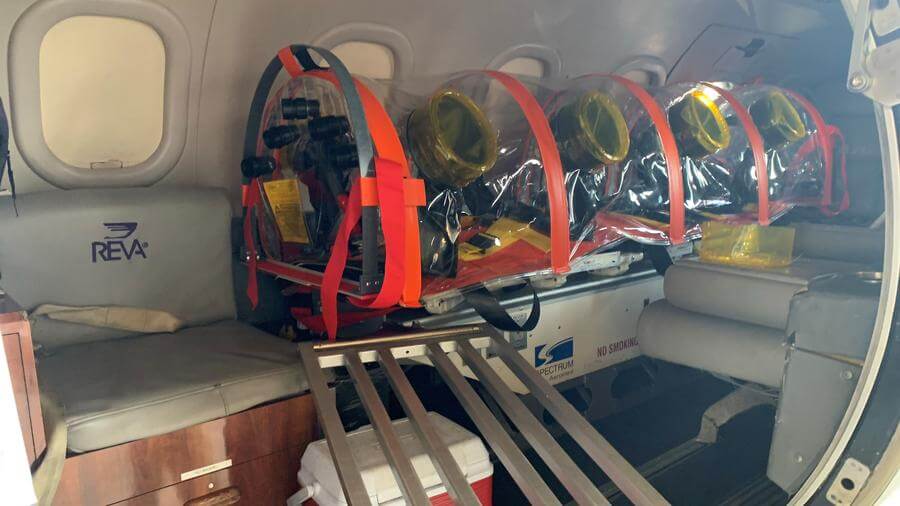Article from AirMedAndRescue.com
Working in isolation
Sean Bryan, RN, BSN, Assistant Director of Medical Operations for REVA Air Ambulance, shares the company’s experiences of transporting Covid-19 patients in an isolation unit.
It’s safe to say that everyone across the medical industry has really felt the impact of the Covid-19 pandemic. Here at REVA, INC our line of work consists of transporting ill/injured patients daily inside a Lear Jet or Hawker at 40,000 feet for an extended period. As this pandemic began to really impact us in the states, collectively as a management team and company we decided to move forward and purchase an isolation unit for transporting patients. Since we purchased the isolation unit, I have seen many other companies around the world utilizing very similar units, and pictures all over the news and social media. One thing I have not seen a lot of are write ups of the dynamics of the unit, and what the whole process is like when you opt to use it. The following article outlines our decision-making process when it comes to utilizing the isolation unit along with the pros, cons, and how our patients feel about lying inside the unit for an extended period.
Sean Bryan, Assistant Director of Medical Operations for REVA Inc., discusses a recent ventilator training exercise undertaken by the air ambulance operator’s medical crew, looking specifically at the need for…
27 Apr 2020 Sean Bryan
Background of the Unit: After a thorough research into multiple different units we were able to decide on one that we felt was best for our operation. We ended up moving forward with a unit that was approved by the FDA. This isolation unit was developed to prevent particulate cross-contamination between the patient and the external environment. The unit was more specifically designed for transporting patients via aircraft, ambulances and ships.
The unit can be utilized as a negative pressure environment inside, or a positive pressure environment.When utilizing the negative pressure environment inside the unit it allows a medical crew to safely isolate a patient inside the unit, and it minimizes the risk of cross-contamination with the surrounding environment. The unit is completely clear so that there is always direct visualization of the patient. On both sides of the unit there are (4) gloved arms so you can have some interaction with the patient, and provide some minimal interventions as needed. To support the unit there are (2) stanchions, one at each end of the unit. In addition to that there are (5) ribs in between to maintain the shape and prevent from collapsing on to the patient. At the head end of the unit there are (5) HEPA Filters and check valves to prevent any back flow. At the foot end of the unit there is a C420 PAPR attached with (2) HEPA/chemical filters to filter out the contaminated air. The unit is sealed with a high-quality pressure sealing zipper that have been specifically designed for space-suit applications. To assist in closing this unit there is also a T-Handle to help close the zipper. It is crucial to have the ability to monitor your patient while they are inside the unit, without having to place your monitor or pump inside. This unit has (6) medical pass-thru ports that will allow you to feed monitor cables, oxygen tubing, and IV tubing through it. After feeding the tubing through the ports you then wrap the ports with chemical resistant tape, overlapping both the tube and wiring by 50% to ensure it is completely sealed. Finally, to safely secure the patient inside the unit there are buckles and harnesses throughout the inside of the chamber. In addition to that there are straps on the outside of the unit to safely secure it to a stretcher system.

Which Covid-19 patients are we utilizing our unit for? After careful consideration and guidance from our Medical Director, Dr. David Farcy, it was deemed that we would utilize an isolation unit for any Positive Covid-19 patients that are currently still symptomatic. In addition to this decision, it was also deemed that Positive Covid-19 patients that are asymptomatic can be transferred outside of the unit, but both Medical Crew and the Patient must wear the appropriate PPE for the transport. In the situation that a request comes in to transport a Positive Covid-19 on a ventilator, it has also been deemed not necessary to place the patient inside this unit, and that it is important that the HEPA filters be placed in the correct location on the ventilator and tubing. In addition to that, Medical is still advised to wear the appropriate PPE, and pack the patient’s nose with ½ inch ribbon gauze and mupirocin ointment.
27 Apr 2020 Editorial Team
Live in Action: Prior to utilizing the unit the entire medical management team spent a significant amount of time learning everything about the unit, and the complete functionality. By the time the unit arrived we all had a complete understanding of how to deploy the unit in less than 10 minutes. We spent most of our time loading and unloading the unit in and out of the aircraft because we felt this was such a high-risk movement in the transport. It is crucial to have all hands on deck when loading the patient into the aircraft because we want to decrease any chance of damaging the device, and potentially not being able to maintain a negative pressure environment. At REVA we utilize Spectrum Aeromed Stretcher systems, and this really makes the loading process in and out of the aircraft much easier. The Spectrum loading system allows us to simply slide the unit attached to the Spectrum sled in and out of the aircraft easily with minimal lifting involved.
For our first transport with the device we decided to utilize the medical management team. The thought process behind this is that we would have a complete understanding of how the entire process goes from start to finish when utilizing in the field. By having this complete understanding, it would allow us to train our medical crews appropriately and be prepared to answer any questions they have for when the unit is deployed, and a live patient is being transported inside. For our first flight we decided to have the unit already set up and secured to our stretcher system. This allowed us to be able to just show up to the hangar and easily load into the aircraft without any additional set up time. When we arrived at our pickup destination you could see the look on the patients face and see that there was going to be some questions when he saw the size of the unit. It’s at this point where education and communication were crucial. When we entered the room, we entered with our full PPE (gown, gloves, mask, goggles, head protection), and only the isolation unit. We left the monitor outside and only brought the cords in so we could prevent contamination of any of durable equipment. Introductions were made and an assessment was completed. We then proceeded to explain the entire unit to the patient, and explain how it functions, and why we are going to utilize this unit for transport. This was received well, and the patient was willing to do anything to protect himself and others. We reassured him that he would always be receiving adequate oxygen throughout the transport and told him he would be receiving supplemental O2 as well. It is crucial to have a patent IV in place in case you need to administer fluids or any IV medications, because in flight you will not have the ability to place an IV or open the unit. Next, the patient is then transferred over to the unit. While one of the crew members is holding up the top portion of the unzipped unit another crew member is connecting the patient to the monitor and running any IV tubing or cables through the ports. While these two crew members are handling this, the third crew member is properly strapping the patient inside and making sure they are comfortable, and that nothing is underneath their body that could cause discomfort. When this part was completed, we then spoke with the patient again and made sure he was okay and asked if he had any concerns or needed anything more before we sealed the unit. This patient was prepared, and the unit was then sealed. After sealing the unit, we then wiped down the entire outside of the unit with cavicide and sani-wipes to make sure that outside of the unit was clean. Outside of the room we then hooked the monitor cables up to the monitor, the nasal cannula to the E-Cylinder, and the IV tubing to the IV pump. All these devices were outside of the room and were never in a contaminated environment.
REVA isolation Pod in Ambulance
At this point we as a medical crew made sure that we were completely prepared and made sure there was nothing further that needed to be done prior to leaving the controlled setting in the hospital. We then loaded into the back of the ambulance for our transport back to the aircraft. Upon arrival to the aircraft the pilot crew already had the ramp set up for loading, and the aircraft powered up with air conditioning. It is crucial that the temperature be appropriate when loading into the aircraft, because if the aircraft is extremely warm inside the patient will not tolerate the environment well and could lead to problems. While loading the patient into the aircraft we made sure to have two medical crew members inside and the third crew member outside the aircraft assisting the pilots and EMS crew. Each person was responsible for watching certain points during the loading. One pilot was responsible for making sure we didn’t catch the device on the door on the left side, the other pilot had direct observation of the door on the right side. Inside the aircraft one medical crew member was responsible for guiding the sled and unit in, while the other was responsible for making sure it was not getting caught on anything. It is important to not rush this at all because if the unit rips or gets caught on something it could lead to cross contamination with the surrounding environment. Throughout the process it is important to keep talking with the patient, always keeping them in the know. Our patient only needed basic IV fluids and oxygen for this trip, as he was treated for his symptoms prior to being placed inside the unit. The only struggle we had during flight with the patient was a when a monitor lead popped off about an hour in while he was moving around. This was a great opportunity to work with the gloves that are attached. Yes, the gloves are a great idea, but they are difficult to work with. With decreased sensation due to the thickness of the gloves it really limits the amount of interventions you can complete. It took roughly 30 seconds to reattach this lead back onto the patient, and it was tricky. We recommend making sure to carry a razor, because in this case the patient had a lot of hair on the torso, so we needed to place the leads on limbs. Had we been able to place the leads all on the torso we would not have had to reattach a lead midflight.
Updated: Patient air transport during the Covid-19 pandemic
Terry Martin discusses the considerations that should be given careful examination before operators take on air medical flights of Covid-19 patients.
2 Apr 2020 Dr Terry Martin
REVA flight nurses
Upon arrival to the drop off destination there were plenty eyes on us as we rolled through the hospital with the unit, and plenty of questions. All the medical personnel really appreciate the time you spend educating them on the device, its not everyday that they see someone being transported into their unit inside of an isolation unit. When we arrived to the room the patient was going to, we then put on the proper PPE again prior to opening the unit. We also disconnected the monitor cords, IV tubing, and O2 line prior to entering the room so we did not contaminate the equipment when we opened the unit inside. After the unit was opened and the patient transferred over to the bed, we then sprayed down the entire inside of the unit with cavicide and allowed it to dwell for 5 minutes. We then wiped the entire inside down, and then proceeded to wipe the entire outside down as well. When we returned to the base we were greeted by our Director of Safety as well as a cleaning crew. This cleaning crew immediately wiped down every inch of the inside and outside of the device, and then proceeded to biostatic spray the device after as well. When the cleaning of the device was completed, they then proceeded to the aircraft. They wiped down the entire inside of the aircraft and then biostatic sprayed that area as well. Following this we debriefed as a crew and talked through what went right and what we felt we could do differently the next time. This flight was a complete success and we had a lot of positives that came out of it. Being able to have a unit that can isolate a patient with Covid-19 and active symptoms from the surrounding environment puts everyone at ease and decreases any chance of cross contamination to the surrounding environment.
REVA isolation Cleaning POD
Recommendations: If you have a patient who cannot tolerate confined spaces this device may not be for them, or you may need to think of some medication to relax the patient. If you do choose to go the route of medication, I would recommend administering the medication prior to placing the patient into the unit to see how the patient tolerates the medication. The last thing you want to do is start giving someone a sedative and the patient not tolerate it well, and it causes the opposite effect. If you have a patient who you think will not tolerate lying flat on their back for an extended period, this may also be an issue. This unit is designed for the patient to be lying flat. What we did was have two pillows inside for the patient to try and make him as comfortable as possible. The only downside to that is you are raising the patients head even closer to the top of the unit and it makes the space feel even more confined. Its crucial to make sure the patient is comfortable before that zipper is sealed shut, because after it is closed it is very difficult to adjust anything underneath the patient because they have very limited space to move inside. If you have a patient who is already having some sort of respiratory distress prior to being placed into the device I recommend escalating this to your Medical Director and seeing if intubating the patient is something that should be done instead of placing the patient inside and he/she potentially deteriorating quickly.
Always be conscious of the temperature inside the aircraft and ambulance. If you are hot, I can guarantee you the patient inside is hot as well if not hotter. If there are any interventions that need to be done, try and complete them prior to placing the patient inside the unit. You will be able to complete very minimal medical interventions once the patient is inside.
If there are any interventions that need to be done, try and complete them prior to placing the patient inside the unit. You will be able to complete very minimal medical interventions once the patient is inside.
It is important to have the leads placed in the correct place, a patent IV line with fluids attached already, and an O2 line running through the ports. Lastly, I can’t stress this enough, communicate and reassure your patient. Constantly communicate with them and talk them through everything you do. This communication will make your transport easier and will make the patient feel more comfortable.
Conclusion: It is great to have an isolation unit and have a unit that allows you to transport patients that are actively having symptoms in a negative pressure environment. We recommend this for those patients that are symptomatic, but stable. If you have a patient that you feel may need to be intubated or may not tolerate lying flat in the unit, it is probably best not to go the route of the isolation unit immediately without consulting with your Medical Director. Anytime a flight is to be dispatched and the isolation unit is going to be utilized, it is important that everyone be involved and agree that this is an appropriate patient for the unit. If there are any concerns bedside, immediately escalate and run this case by your Medical Director. I think an isolation unit is a great piece of equipment and I feel that everyone should have one in the transport industry.

